 |
|
"Almost
all of the occupations which
will be affected by
nanotechnology will require a BS
in engineering with a broad,
interdisciplinary and
multi-disciplinary approach, and
an understanding not only of
electrical, mechanical
and civil engineering, but
biology, physics and chemistry
as well " why is Liberal
Arts UNCG in Nano. |
|
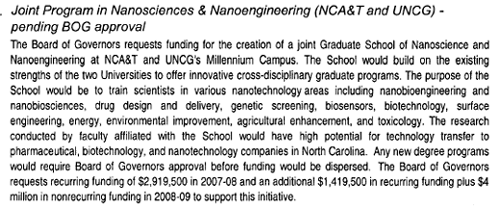 |
 |
|
|
|
|
Liberal Arts University of North Carolina at
Greensboro offers Doctoral degrees in English,
Psychology, Education, Nutrition, Human
Development and Family Studies, Exercise and
Sport Science, and Music none of which
constitute an under standing of electrical,
mechanical, and civil engineering. |
In 2006 in the category of Doctorial
Granting Universities NC A&T was rated
as a High Research University in the
Carnegie Foundation classification of
colleges and universities.
NC A&T
the largest producers of BS. and PhD
minority engineers in the country,
offers approved master's degrees in
Civil
|
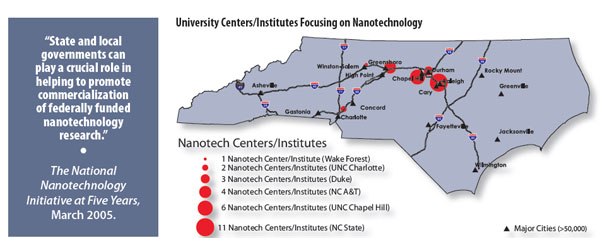 |
|
University Centers/Institutes Focusing
on Nanotechnology, A Roadmap for
Nanotechnology in North Carolina’s 21st
Century Economy, APRIL 2006, NC Board of
Science & Technology |
|
|
Engineering, Chemistry, Biology,
Industrial Systems & Systems Engineering,
Electrical Engineering, Mechanical Engineering,
Computer Science, Chemical Engineering, Physics,
Computational Science and Engineering, as well
as doctoral degrees in Energy and Environmental
Systems Engineering, computational Science and
Engineering, Electrical Engineering, Mechanical
Engineering, and Industrial and Systems
Engineering. "NC
A&T has a 12-year history in Nano research and
has been funded at a rate of $3 to $5 million
per year".* |
|
 |
|
PCG/UNC-NCCCS/UNC Interim report
3.doc/RB.SP.PC.CR.ATPCC.1/CC.14/10May05 Page 34 |
 |
|
UNCG 2006-07
Academic Profile Source : www. UNCG. edu |
 |
|
Southern
Association of Colleges and Schools (NC A&T) |
|
|
Nano scale Technologies are
Experimental |
|
In 2011 HMI
North Carolina A&T for the 7th
consecutive year garnered the third
largest highest amount of sponsored
research in 17 constituent UNC system
surpassed only by UNC flag ships
UNC-Chapel Hill and NC A&T holds
patents in Advanced Materials,
Nanotechnology, |
Biotechnology, Computational Science,
Environmental Sciences, Transportation
Systems, and Public Health, for
seventh consecutive year achieved the
third highest research funding in the
16-constituent University of North
Carolina System with over $60 million
dollars.
|
North Carolina A&T Nano Centers |
-
Center for Advanced
Materials and Smart
Structures
-
Center for Nanoscale
Chemical-Electrical-Mechanical
Manufacturing Systems
-
Engineering Research Center
for Revolutionalizing
Metallic Biomaterials
-
Center for Nanoscience and
Nanomaterials
|
|
UNC at Greensboro Nanoscience
Centers |
-
Center of Research
Excellence in
Nanobiosciences
Source: North Carolina Board
of Science and Technology |
|
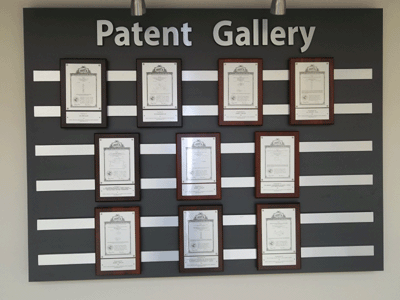 |
|
|
NCA&T State University has been
funded at an average rate of
$3-5 million per year in the
area of nanoscience and
nanotechnology. Most of the
research in nanoengineering is
done in the Center for Advanced
Materials and Smart Structures (CAMSS).
Several Centers and projects are
under CAMSS, including the NSF
Center for Research Excellence
in Science and Technology
(CREST), the DoD Center for
Nanoscience, Nanomaterials and
Multifunctional Materials (CNN)
for Homeland Security, the NSF
Nanoscale Science and
Engineering Center (NSEC), the
NSF project on US/Europe
Materials Collaboration:
Self-Organized Nanostructured
Thin Films for Catalysis, the
NSF project on Nanoscale
Interdisciplinary Research Teams
(NIRT), the NSF Major Research
Instrumentation for
Nanoengineering Research, and
the NSF Nanotechnology
Undergraduate Education (NUE)
program. CAMSS also facilitates
many of the materials research
activities of the NASA-National
Institute for Aerospace (NIA).
In addition, the Center for
Composite Materials Research (CCMR)
does research in nano-enhanced
composite materials and the Army
Center of Excellence for
Battlefield Capability
Enhancements (Flexible Displays)
does research in material
characterization and development
of novel displays. [ ] |
|
|
|
|
|
|
UNC at Charlotte proposed UNC Tomorrow
Statewide Nano Network collaboration
between UNC institutions involved in
nanotechnology and Nanoscience excludes
NC A&T and NC Central. Between 2000-05
NC A&T conducted 11 Millions dollars of
nanotechnology research compared to 5.5
million at UNCG and $44,000 dollars at
UNCG. HBI NCCU conducted 2.3 Million
compared to $44,000 at UNCG.
|
 |
|
UNC Tomorrow
Continuation Of UNC Yesterday |
|
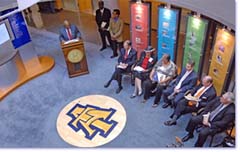 N.C.
A&T Awarded NSF Engineering Research Center
- Shena
Crittendon N.C.
A&T Awarded NSF Engineering Research Center
- Shena
Crittendon
North Carolina A&T State University has been awarded a
grant for an Engineering Research Center (ERC) from the
National Science Foundation (NSF). Engineering Research
Center grants represent major investments by NSF in
partnership with industry to transform engineering
research and education. The centers aim to produce
innovative technologies and engineering graduates to
significantly enhance the competitiveness of the
U.S.
economy. |
|
Award
funding has been approved at $18 million for the initial
five years, with a potential duration of 10 years. The
NSF ERC for Revolutionizing Metallic Biomaterials at A&T
will conduct research in the areas of biomedical
engineering and nano-bio applications and is in
partnership with the Universities of Cincinnati and
Pittsburgh. It also has a global technical partner
in Germany’s Hannover School of Medicine and a global
cultural and outreach partner in the Indian Institute of
Technology, Madras, India. California State University
at Los Angeles will serve as an outreach partner in the
USA. The ERC has partnerships with pre-college
institutions in North Carolina to involve teachers and
students in engineering; it has partnerships with a
broad range of North Carolina organizations devoted to
entrepreneurship and small business development. |
|
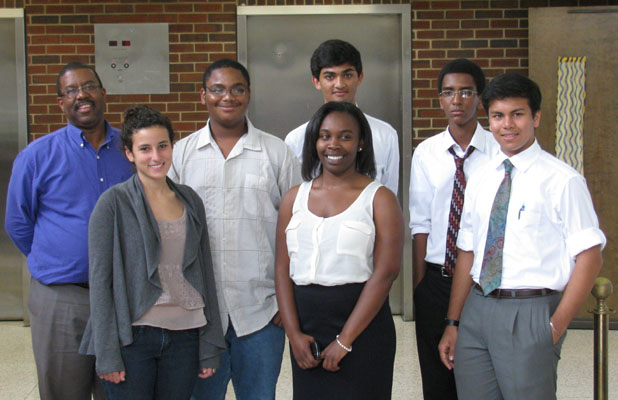 |
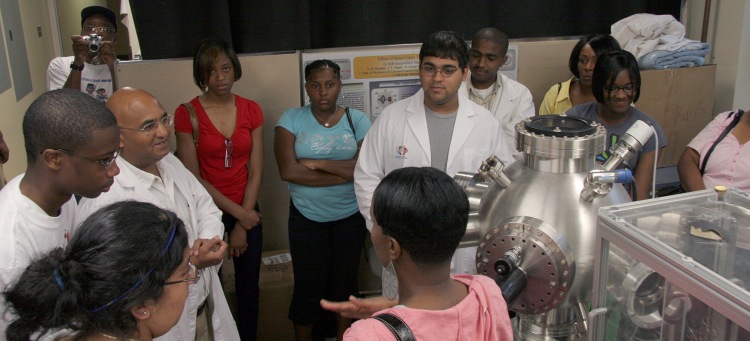 |
|
HIGH SCHOOL
STUDENTS SPEND SIX WEEKS AS BIOENGINEERING
RESEARCHERS |
|
|
High school
students see the pulsed laser deposition
|
| North
Carolina A&T State University was selected as a host
institution for Brazilian students participating in the
Brazil Science without Borders program. The U.S. State
Department reports that last year, President Obama and
Brazilian President Rousseff, “set complementary goals
for international education. President Obama announced
the “100,000 Strong for the Americas” initiative to
increase international study with a target of 100,000
students from Latin America and the Caribbean studying
[in the] United States, and a reciprocal 100,000
students from the United States studying in the Latin
American and the Caribbean region.” |
 [
Former UNC] President Molly Broad,
.... shared that by 2020, 70 percent of the World's
Scientist will live and work in Asia, unless the country
does some different kinds of things. She said that
North Carolina
A&T is in a position to educated and graduate
world-class scientists because of initiatives
underway within our science and technology areas, and
now is the time for the university to step up to the
plate to meet the challenges ahead",
said Dr. Speight-Buford, NC A&T Fourth Regular Board of
Trustees meeting April 20, 2005. Univ. Nebraska Photo [
Former UNC] President Molly Broad,
.... shared that by 2020, 70 percent of the World's
Scientist will live and work in Asia, unless the country
does some different kinds of things. She said that
North Carolina
A&T is in a position to educated and graduate
world-class scientists because of initiatives
underway within our science and technology areas, and
now is the time for the university to step up to the
plate to meet the challenges ahead",
said Dr. Speight-Buford, NC A&T Fourth Regular Board of
Trustees meeting April 20, 2005. Univ. Nebraska Photo
|
|
|

